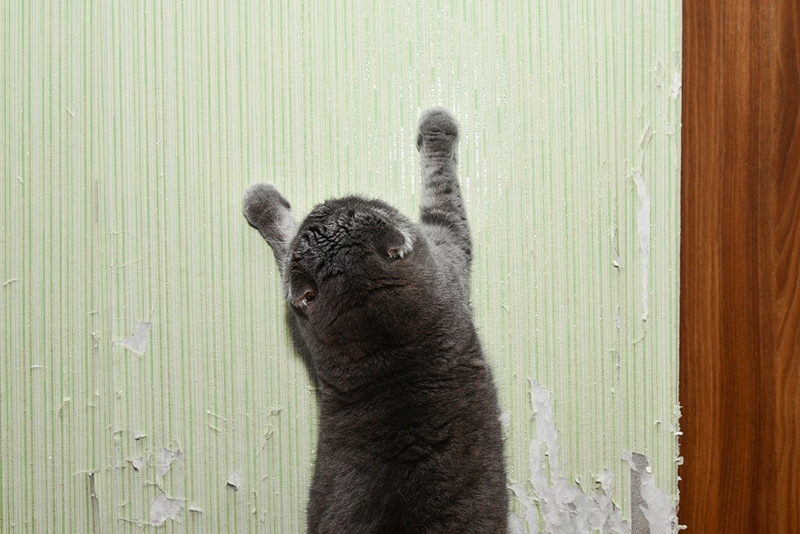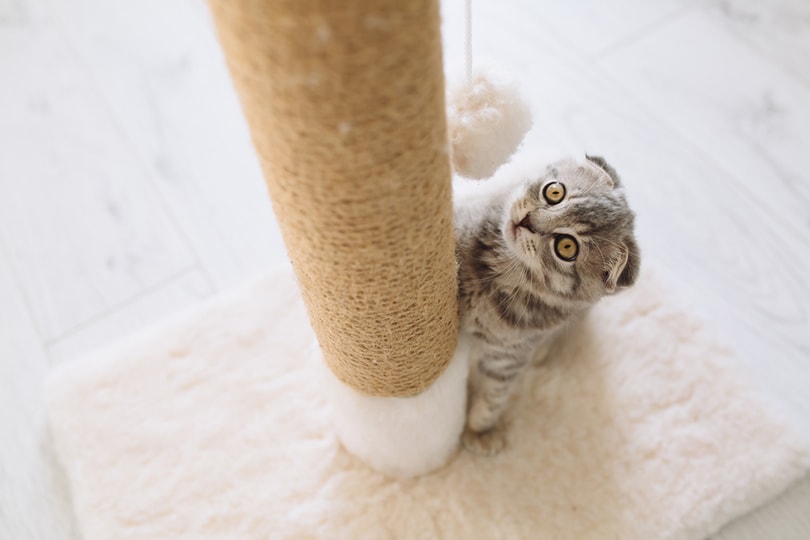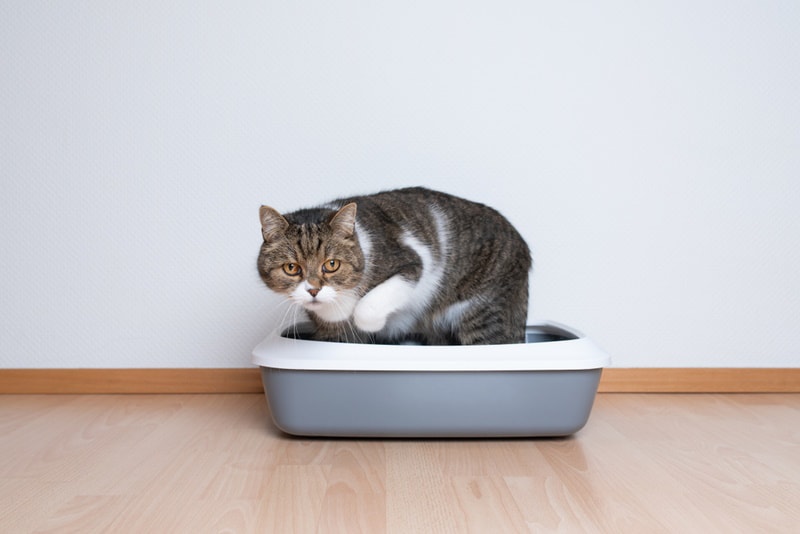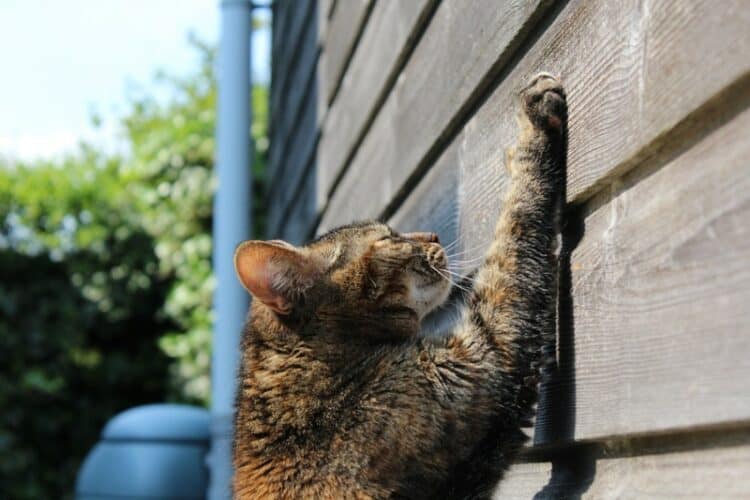Cats may scratch the wall for all sorts of reasons. However, the most common reasons are for marking (cats have scent glands in their paws) or to keep their nails healthy.
If your cat is scratching the wall, you probably aren’t too happy about it. Cat nails can do plenty of damage on a wall, especially if they make it one of their favorite spots to scratch. Luckily, we’ll explain how to stop this behavior below.
Reasons for Wall Scratching
Here’s a list of possible reasons why your cat may be scratching the wall:
- Marking Territory: Scratching is a way for cats to mark their territory visually and with scent. When they scratch, they leave both visible marks and scent from their paw pads, which helps establish their territory and communicate with other cats.
- Stretching and Exercise: Scratching is a natural way for cats to stretch their muscles and maintain flexibility. It also allows them to exercise their front legs and paws.
- Maintaining Claw Health: Scratching helps remove the outer sheath of a cat’s claws, keeping them sharp and healthy. Cats need to scratch regularly to prevent their claws from becoming overgrown.
- Relieving Stress and Anxiety: Cats may scratch as a way to alleviate stress or anxiety. It can be a self-soothing behavior for them when they feel uneasy or unsettled.
- Boredom or Restlessness: Cats that are bored or not getting enough mental and physical stimulation may resort to wall scratching as a form of entertainment.
- Attention Seeking: Some cats may scratch walls to get their owners’ attention; if they have learned that scratching results in a response from you, they may continue the behavior.

How to Stop Your Cat from Scratching the Wall
There are many ways you can redirect your cat’s behavior and make them stop scratching on the wall. Of course, the reason your cat is scratching the wall matters. You’ll preferably want to stop the scratching using a method that aligns with your cat’s underlying reason.
- Provide Scratching Posts: Offer your cat suitable alternatives, like scratching posts or pads made of materials they enjoy, such as sisal or cardboard. Place these posts near the areas where they tend to scratch walls.
- Catnip or Attractants: Sprinkle catnip on the scratching posts to encourage your cat to use them. Additionally, you can use special cat attractant sprays on the posts to make them more appealing.
- Trim Their Claws: Regularly trim your cat’s claws to keep them at a healthy length. This can reduce the damage caused by scratching.
- Environmental Enrichment: Ensure your cat has enough mental and physical stimulation by providing interactive toys, puzzle feeders, and playtime sessions with you.
- Positive Reinforcement: Whenever you catch your cat using the scratching post or engaging in appropriate scratching behavior, praise and reward them with treats or affection.
- Protect the Walls: In the meantime, you can protect the walls by using sticky tape or double-sided tape on the areas your cat usually scratches. Cats dislike the sticky feeling and may be deterred from scratching there.
It’s vital that you figure out why your cat is scratching and then use a variety of these techniques to stop the behavior altogether. You’ll need to be patient, as these techniques take some time to work. Protecting your wall should be done in the meantime to prevent further damage.

Why Does My Cat Scratch the Wall After Using the Litter Box?
It’s not uncommon for cats to scratch walls after using the litter box for a few possible reasons. One of my cats did this for years and then suddenly stopped. Often, this isn’t a huge issue unless your cat is damaging the wall.
If your cat is damaging the wall, then putting a stop to the behavior may be necessary. Here are some reasons cats may scratch the wall after using the litter box:
- Territory Marking: Cats have scent glands in their paws, and when they scratch walls, they leave behind their unique scent, which serves as a way to mark their territory. This territorial behavior might be more pronounced if they feel the need to assert their presence in certain areas of your home.
- Litter Box Preferences: Your cat might have specific preferences when it comes to the litter box. They might not like the type of litter, its depth, or its cleanliness. If the litter box doesn’t meet their standards, they may seek alternative surfaces to scratch on after relieving themselves.
- Litter Box Placement: The location of the litter box matters to cats. If it’s in an area that feels unsafe or unpleasant to them, they may choose an alternative spot, like a wall, that seems more secure or secluded.
- Dirty Litter Box: If the litter box is dirty, the cat may not want to touch it. Therefore, they may scratch somewhere else in an attempt to cover up their waste.
There are many ways you can correct this behavior. Because the litter box is specifically involved, the methods will be a bit different than above.
First and foremost, prioritize litter box hygiene by ensuring it remains clean. Daily scooping of waste and regular litter changes is essential. Cats have a preference for clean environments when it comes to elimination. For households with multiple litter boxes, it’s crucial to provide enough options in various locations. This helps avoid competition between cats and grants each feline their own private space for comfort.
Stress reduction plays a significant role in encouraging appropriate litter box behavior. To create a calm and secure environment, offer hiding spots, vertical spaces, and familiar objects. These measures help cats feel safe and can reduce stress-related issues.
Positive reinforcement is a powerful tool for reinforcing desired behavior. When your cat uses the litter box correctly, praise and reward them. Positive reinforcement encourages them to continue the preferred behavior.

Why Does My Cat Paw at Walls?
Cats may paw at walls instead of truly scratching them for a few reasons. You’ll need to look at your cat’s behaviors and body language to figure out the reason behind their behavior. Sometimes, cats try to scratch the wall but find the angle difficult. In this case, they may appear to be pawing at the wall when they’re really trying to scratch it.
Other cats may jump up and paw the wall in an attempt to play. They may have seen dust or shadows on the wall that set off their hunting instincts. Kittens are more likely to paw at walls for this reason. Other times, cats may simply paw at a wall because they are curious. If the wall is textured or dirty, the cat may paw at the wall to figure out what’s on it.
Final Thoughts
Cats may scratch a wall for all sorts of different reasons. Marking their territory and keeping their nails worn down are two of the most common reasons. However, other cats may do it to relieve stress, seek attention, or play.
It is possible to prevent this behavior from occurring, but it does help to personalize your plan to your cat’s why. If your cat is using the wall to sharpen their nails, you may want to provide some extra scratching posts, for instance. You may even want to trim your cat’s nails if they are unnecessarily long.
In many cases, environmental changes and positive reinforcement can go a long way to stopping wall scratching—no matter the underlying cause. Always remember to protect the wall with sticky tape or another deterrent to prevent further damage while you teach your cat to scratch elsewhere.
Featured Image Credit: Piqsels














